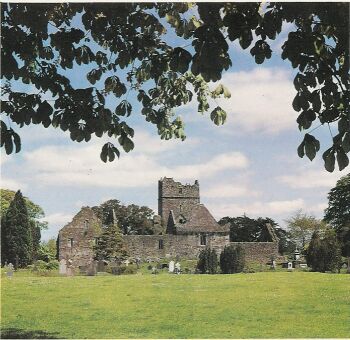Franciscan Friary, Killarney
| The first Franciscans came to Ireland, probably in the summer of 1226 landing near Youghal, Co. Cork. Soon there were many Franciscan foundations throughout the country. All of these, however, were suppressed during the Reformation.
The formal ecclesiastical permission to make the present Franciscan foundation at Killarney dates from 1860. The building of the Church commenced in 1864 and was completed in 1867, as a stone over the Church door bears witness. The Friary proper was built in various stages between 1865 and 1878. The Church is dedicated to the Most Holy Trinity. At present, the Friary is the novitiate house of the Irish Franciscan Province. |
 |
Muckross Abbey
The title of the present Church links the Friary with its great predecessor, Muckross Abbey,
more correctly called Irrelagh (Oir-bhealach, Eastern Way). This old Friary is situated near the shores
of Lough Leane in the Killarney National Park, some three miles from the town. It was founded ca. 1448
with the help of the McCarthy Mor family and was the residence of the Friars until 1698, with some
interruptions due to their expulsion under Elizabeth I in 1589 and Cromwell in 1652. The final dispersal
took place as a result of the Penal Laws which came into effect on 1st May 1698. Under these laws all
bishops and religious were to leave the country under pain of imprisonment or transportation.
The Franciscan Provincial of the time Fr Anthony O'Kelly, decided that the law should be obeyed.
In that year many, though not all, went into exile to France or Spain, only to return secretly at the
first opportunity.
Dedicated Friars
 |
Prior to this final trial, Muckross had been sanctified not only by the lives of those who lived
there daily, but also by the martyrdom of Fr Donagh O'Muirthile and his companions, who after the
flight of the community hid the sacred vessels and other church valuables on one of the islands of
the lake. They were put to death by the soldiers of Elizabeth I in 1589.
The Abbey had also been home to the valiant Fr Francis O'Sullivan who was born in Ardea, in the
parish of Tuosist beyond Kenmare. He was Provincial of the 62 Franciscan houses in Ireland from 1650,
and was put to death in 1653 on Scarriff Island off Derrynane. His body lies somewhere on that
sea-swept rocky island, but his skull is still preserved in the sacristy of the Killarney Friary.
|
Because of such a heritage, many of the friars preferred to go into hiding rather than to accept exile.
For the next 80 years or so, their places of refuge were small cottages in isolated places -especially in
what is known as Friars' Glen, between the mountains of Mangerton and Torc. From there they continued
their pastoral ministry among the people.
Sixteen years after the enactment of the Penal Laws, the Protestant Bishop of Limerick reported to
Dublin Castle that there was an old man, ex-Superior of Irrelagh (Muckross), living at Five-Mile Bridge
outside Killarney on the road to Macroom. He was Fr. Florence McCarthy, seven times elected Guardian of
Muckross, and a man who spent most of his life attached to that Friary.
Other names come down to us through the years: Daniel Falvey, Cormac McCarthy, John Brown, Francis
Callaghan. Among them we meet a Fr. O'Sullivan who found time to collect valuable material for the
compilation of the Ancient History of the Kingdom of Kerry about the year 1750.
The surrounding districts came to know these men without a friary and consequently they found a home
in every Catholic house. If Muckross was desolate and deserted, its spirit was not dead. Guardians
continued to be appointed to the Abbey though they could never hope to take possession.
Continue

